The Next Twenty-Five Years
22
‘Or Strength to Weakness’
____________
Dates in Re: August 1970 to April 1974
Although I can recall the visions and a number of other things I experienced between January 14, 1969, and mid-July 1970, the only evidence I have about what my life was like between late fall of 1970 and the first quarter of 1972 are:
• a few scattered memories,
• some personal notes ,
• some photographs,
• a letter from one of the ODU 1971 staff professors, and
• several of the books in my at-home library.
According to the information on paper records or in mind, the only secular educator I shared any of my original records of the spiritual happening with was an ODU math professor sometime between the fall of 1970 and early to mid-1971. No oral synopsis was provided by me, for I had not yet developed the courage to speak openly about the extraordinary spiritual happening I had undergone.
Neither had I made any attempt to interpret the visions I had experienced. It was my hope that some college professor or scientist would help me figure out the significance of the sensory and pictorial visions I experienced between January 14, 1969 and July 14-15, 1970. For various reasons, that did not happen.
But in retrospect, I can see that I was not sufficiently in charge of my emotions at that time to motivate anyone to try to take me seriously. As I recall, much of what I said at the time was in the form of insinuations. Without any knowledge of Biblical Hebrew grammar to help me evaluate the Exodus account, I skirted over instances in my experience which corresponded to some of those recounted of in Exodus. But again, the main lack of high interest on the part of the educators I spoke with at ODC was no doubt due to my inability to present my case in a sufficiently coherent manner.
Mid-November 1971
At various times between January 14, 1969, and July 14-15, 1970, I had experienced severe headaches. By mid-November1971, they had become so painful I could no longer bear them, and called my family doctor’s office for an appointment. After seeing me, Doc made arrangements for me to be admitted to Norfolk General Hospital. The only other thing I remember following admission to that hospital and my return home around December 23, 1971, was (a) myself lying face down on a gurney with an orderly at either side, and (b) myself seated beside my husband in the hospital solarium.
As it turned out, it would be several years before I would learn the reason why I was admitted the hospital and given numerous electric convulsive therapy shock treatments over a period of six weeks.
April 1972
Following the hospital stay, I gradually worked my way back to participating in social activities. The first clear recollection I have of a social outing was a family gathering at my parent’s home in Mathews County, Virginia, during the “spring break”of April 1972. All four of my siblings were in town. Some of my nieces and nephews were also present. Three of my four children were at the gathering. I do not recall where seventeen-year-old son David was on this weekend. James, Jr. had brought his 35MM camera along. It was he who took the following treasured photograph of Ernest Hugate and Marion Sadler Hugate with their children, most of their grandchildren, and all but one of their children’s spouses.

Fig. 95. From left to right on front row: Darryl Gatlin , Jean Walker Hugate (wife of Milton Hugate), Donna Hugate, Anne Hudgins, Jeannie Pierce, Lisa Hudgins, Teresa Hugate, Jimmy Pierce, Marion Sadler Hugate, and Ronald Hugate. From left to right on second row: Anne Pierce, James (Jim) Story, Margaret Hugate Story, Elizabeth Hugate Hudgins, James Hudgins, Sr., and Ernest Hugate. From left to right on third row: Milton Hugate, David Hugate, Billy Gatlin, Jean Hugate Gatlin, and Albert Gatlin.
 Fig. 95.1. James, Jr.
Fig. 95.1. James, Jr.
The Hudgins children in the group picture are of course the children of my husband [ James (Mac) Hudgins] and me. Anne, Jeannie, and Jimmy Pierce are the children of Margaret Hugate Story. Teresa Hugate is the daughter of David Hugate. The other Hugate children are the children of Milton Hugate and Jean Walker Hugate. Young Don Gatlin was present, but did not line up for the photo shoot.
Alas, no one thought to get a group photo including the photographer. The one at left is a copy of one taken by me inside our house on James’ high school graduation day in June 1971.
James also took the photograph of my siblings and me with our parents inside the house included on this entry’s Endnotes’ page.
1972 - 1974
Sometime between April 1972 and the opening of the 1973-1974 public school term, I had decided to visit a Jewish synagogue of the Reform denomination. From what I had heard about it, the tenets of the Reform branch of Judaism might not be too far from my own. At the time, Ohef Sholom in Norfolk was the nearest Reform Jewish synagogue, so that’s where I went.
One of the most appealing aspects of the first Jewish Sabbath service I attended was the absence of people with offering plates walking down the isles collecting money. How pleasant it was to not have that distraction to break the mood of the “worship” service. Then there was the part I did not like: the talking done by some of the congregants while the rabbi was conducting the service. I simply could not imagine such willful rudeness. Yet, the rabbi seemed to be oblivious to the distracting talkers. Had I been the presiding person, I would probably have stopped speaking, and given the disruptive persons my most stern glare of disapproval.
After the Friday evening service, there was a light reception called “Oneg Shabbat” (Sabbath delight). That was a surprise, too. Some of the people came up to me and introduced themselves, but no one said anything to me about becoming a Jew, or even coming back again. This absence of an immediate proselytizing embrace was another new thing for me. Did they not care whether I came again or not?
Lawrence Forman was the rabbi. He was a good speaker. I was impressed with his style and general warm manners, and decided to come back again. Even after coming back again, no one said anything to me about joining the congregation or confirming to Judaism.
Another pleasant thing about the Ohef Shalom congregation was the breakfast prepared and served by the synagogue’s men’s club each Sunday morning (not a Sabbath, only a day of religious school classes, The Jewish Sabbath is from Friday sundown to Saturday sundown). It was my first time to attend a religious institution where the food was prepared and served by men rather than women. I liked that. In fact, I liked it a lot. Usually, there was also a speaker at each of these Sunday morning breakfasts. The topics varied, but all were interesting and included some beneficial (to me) information. I do not recall how many visits I had made to the synagogue before I enrolled my daughters Lisa and Anne in the religious school program, but I do recall what as “moved” me to do so:
Anne comes in from school with tears in her eyes. When I ask her what’s wrong, she starts crying. I do not recall the exact words; but in essence, the reason she gives for her distress is that some of her classmates had mocked her because she does not go to church. I could not bear the image of this tender-hearted loving child undergoing such mockery. Although a little uneasy about letting my impressionable daughters get involved with institutional religious instruction, I decided to see about getting both Anne and Lisa started in the Ohef Sholom religious school program. The girls could benefit, I concluded, from some reinforcement lessons in ethics, . . . and I would be monitoring their studies.
Both of the girls were enrolled as students in Ohef Sholom’s religious school on October 21, 1973. At ages twenty-one and nineteen respectively, my sons' James and David were no longer under my legal custodial care. While it was my expressed desire that they would resist idolatrous practices, the choice was solely theirs now that they were “men.”
Since I had to be at the synagogue anyway, I also started studying Judaism. Rabbi Forman gave me a reading list of more than fifty books' length on “Turning to Judaism.” Ohef Sholom had a well-stocked library. During the years between 1973 and about 1981 (the year I transferred my membership to Beth Chaverim, a Reform Jewish congregation in Virginia Beach), I read through almost every book on that list of recommended reading. One of the books was Wings of the Morning,190 a textbook designed for confirmation age Jewish youth (but not used at that time by Ohef Sholom). The “Thought Starters” question at the end of each chapter of the book provided me with the structured opportunity to express my views on Jewish religious thought and its congruency (or lack of ) concerning involuntary natural events. And although that level of participation was not required of me, I did the questions and turned in my responses to Rabbi Forman. When I completed the textbook course in 1974, the rabbi presented the book to me as a gift. I treasure it.
190 Roland B. Gittlesohn (New York: Union of American Hebrew Congregations, 1969). WOM Note: Roland B. Gittelsohn died in 1995. The first Jewish chaplain ever appointed by the Marines, he was there at Iwo Jimo along with about 1500 other Jewish soldiers during the battle in 1945. It was Rabbi Gittelsohn’s job, however, to minister to Marines of all faiths in this combat zone.
To give you some idea of the general attitude of the author of the book, I am including a copy of the last paragraph of: No Conclusion, the last chapter in Rabbi Gittelsohn’s book:
May you reread these pages from time to time. May they always stimulate a process of serious thought which will never end, to the final day of your life. May you find comfort and challenge in the asking of such questions as these and the answers proposed by Judaism. In religion, as in all other aspects of life, may you never grow fearful of new ideas or of change. For change can mean growth. And growth means progress. And progress means that we have moved a little step forward and upward in our yearning to reach . . . [The Almighty Thou].
At various places within the context of his lessons, Rabbi Gittlesohn had inserted one or more Hebrew words. On page 199 of the chapter: Thou Shalt . . . Thou shalt not! are the Hebrew words, English transliterations, and the English translations for our two opposing impulses: cuy rmh
(“yetzer tov”)–the inclination to do good, and gr rmh (“yetzer ra”)–the inclination to do the opposite or bad things. As for the ultimate consequences of bad choices, on page 354 of the chapter: After Death, What?, no specific definition is given on the literal meaning of the Hebrew word kuta:191
Judaism has been singularly free of belief regarding heaven and hell. The Bible does mention a rather vague, indefinite place called kuta (She-ol), to which the wicked are apparently[
192] consigned, at least temporarily after death, but nowhere is kuta described in detail or made into a necessary tenet of Jewish faith.
Statements like the above-cited ones stimulated my interest in how to pronounce and decipher the meaning of the Biblical Hebrew words I had seen in the book. Perhaps my curiosity showed? Anyway, sometime after I began this self-imposed textbook course on Judaism, Rabbi Forman suggested that I start studying Hebrew. No adult Hebrew instructor was available at the time. My first few lessons in the Hebrew alphabet were given by the Sharon Forman, the rabbi’s seven-yearold daughter. What a neat unprecedented experience it was for me to have a young child for a teacher. However, this private tutoring in the library back room only lasted a few weeks. A class was setup for those who wanted to study Adult Hebrew. But both the availability of instructors and the scope of study were limited. It was not until after I had joined Congregation Beth Chaverim of Virginia Beach that I began a comprehensive study of the grammar and syntax of Classical/Biblical Hebrew. I also completed two semesters of Hebrew at Tidewater Community College in 1983 under the instruction of retired chaplain Rabbi Sobel. The textbook used for that college credit course was: Introduction to Hebrew193
191 I have since learned thatkuta is from the verbal rootkta (ask, inquire), and means place of inquiry. 192 This is not apparent; nothing about afterlife is definite.
Along with a small group of other interested congregants, I also completed a course of study entitled Modern Hebrew194under the direction of Rabbi Zoberman at his home on Monday evenings. This schooling took place sometime after 1983.
When I first sat down with little Sharon Forman in 1973, it was merely to acquaint myself with the shapes and sounds of the Hebrew letters and vowel signs so that I could read along in the “sedur” (prayer book) during the Sabbath and other holiday services. Never, never did I ever expect to learn enough Hebrew to someday be able to read the five books of the Hebrew Torah.
Public school term 1973-1974
In the fall of 1973, I also began working with the Volunteers In Education program at John B. Dey Elementary school. One day a week I served as a volunteer teacher aide for a first grade class. My job was to take aside and help students who, for one reason or another, needed additional help with reading and mathematics. I was also assigned the task of doing the monthly classroom bulletin board.
When December came around, I was in a bit of quandary. Whereas I could go along with the teacher’s required Santa Claus theme, I could not agree to put up the greetings' sign: “Merry Christmas.” As it turned out, she did not insist that I do it. Nor did she put up the sign.
193 Moshe Greenberg, (New Jersey: Prentice-Hall, Inc, 1965). ITH
194 Harrt Blumberg, and Mordecai H. Lewittes, 3rd ed. (New York: Hebrew Publishing Company, 1965). MH
Workshops had been set up for training volunteers. These weekly training sessions were held at night in different elementary schools throughout the City of Virginia Beach. Still suffering from some memory loss, I could not trust myself to find my way to and from these unfamiliar locations after dark. My husband suggested I do a trial run earlier in the day. With the aid of a city map book and these test runs, I managed to make it to all the workshops and back home without getting lost.
Each of the three years of doing this volunteer work I was awarded a certificate of appreciation for the help I had given to John B. Dey Elementary school. A scanned copy of one of the certificates is included in the Endnotes part of this entry.
˜
ENDNOTES I.
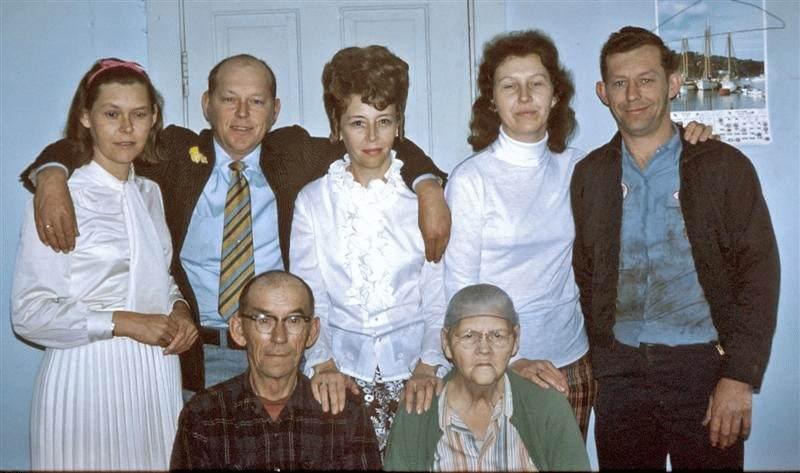 Fig. 96. From left to right on front row: Ernest Hugate and Marion Sadler Hugate. From left to right on back row: Elizabeth Hugate Hudgins, Milton Hugate, Margaret Hugate Story, Jean Hugate Gatlin, David Hugate.
Fig. 96. From left to right on front row: Ernest Hugate and Marion Sadler Hugate. From left to right on back row: Elizabeth Hugate Hudgins, Milton Hugate, Margaret Hugate Story, Jean Hugate Gatlin, David Hugate.
As previously noted, this photo of my four siblings and me with our parents was also taken by my son, James Hudgins, Jr. in the spring of 1972.
Brother David had come directly from work. Since his job involved working on automobiles and other greasy objects, his shirt is dirty.
Mama had plenty of hair. But for some reason, she began stuffing it in a hair net after it turned grey. Like Daddy, she was toothless by the time she reached middle age. But unlike Daddy, she never did get any false teeth. She did not smile often.
There was always a calendar (with advertising) hanging in the living room. Some county merchants handed them out free. To my recollection, the pictures included on these annual calendars were the only type of pictures to ever hang on my father and mother's parlor walls.
II.
Certificate Example:
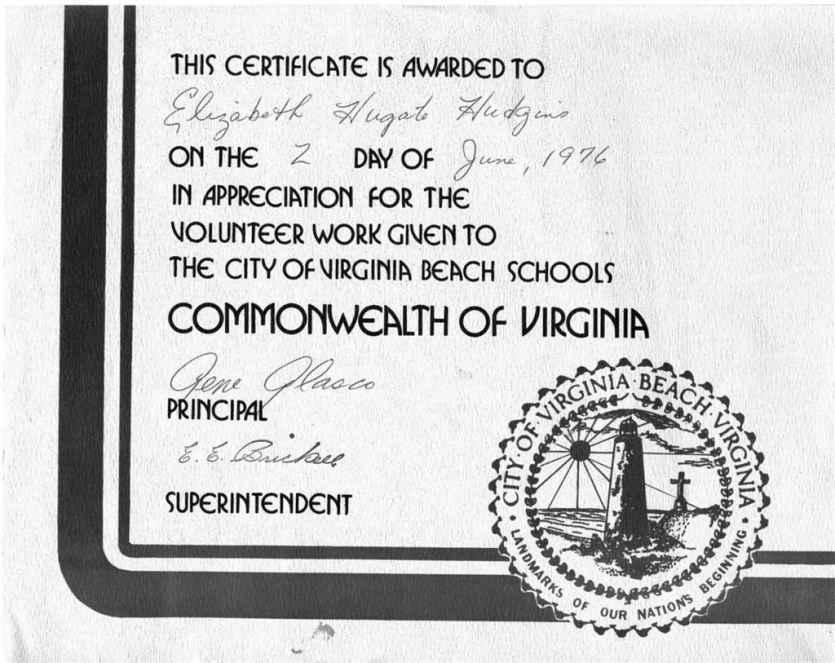 Fig. 97. Scanned copy of document.
Fig. 97. Scanned copy of document.
23
’And Often Back Again’
____________
Date in Re: April 1974
Place: Old Dominion University Event: A Shocking Discovery
HIaving come across a nice letter from the Chairman of the ODU Department of Biology, I decided to try to find the recommended books on organic evolution. When a trip to the local branch of the Virginia Beach public library failed to produce positive results, I decided to go to the university campus library and see if the referred books might be there. After stopping by the math department to say hello to an acquaintance of mine, I proceeded on to the office of Dr. Harold Marshall in the science department building. We exchanged the customary polite greetings. I also spoke to the secretary. A faintly puzzled look flashed across her face; however, she responded to my greeting in a warm and courteous fashion. My stop-by was brief. I then went on over to Hughes Library to do the book search.
Checking in the card catalog file cabinet, I located the cards for four out of the five referred books, jotted down the section numbers where they were shelved, and was about to go get them--when a police officer came up to me. Taking my arm, he directed me to follow him to a room at the back of the library. It was mind-boggling. I had no idea of why this was happening to me, no idea at all!
 Fig. 98. Crop of “cardcatalog.jpg,” Credit of the photo: Greg Shattuck.
Fig. 98. Crop of “cardcatalog.jpg,” Credit of the photo: Greg Shattuck.
When we got to that room, there was another uniformed campus officer waiting. That second officer opened a notebook and showed me a copy of a letter that had been sent to me in October 1971 informing me that due to certain complaints by some staff members, my patron privileges to ODU had been terminated. The cited complaints were: (1) I had taken up too much of their time with matters that were not pertinent to their subject, and (2) I had defaced some library books. The officer with the notebook further informed me that I was "trespassing," . . . was "persona non grata," he said. Based on the text of the letter, the word trespassing fit my of-the-moment deed. Albeit inadvertent or unintentional trespassing, I was nonetheless trespassing. But why did the officer add the “persona non grata" (i.e., a person who is not welcome or acceptable--SCD)?
Who, I wondered, called the campus police? My guess is the librarian did. She would--I soon came to realize--have had the legal reasons for doing so. For upon examining some of my own books, I could understand what was meant by “defacing state property.” Some of my books contained numerous unerasable strikeouts and comments. In some cases, the defacements could be removed with bleach. Other books, however, had to be trashed.
On this date, my thoughts were focused upon getting my patron privileges reinstated. It was unthinkable that I might not be able to attend the graduation service of my own children from ODU (should one or more of them decide to seek a degree at this Virginia state school).
When my husband returned home from work that day, I asked him about the exclusion letter. "Why," I asked, "didn't you warn me this morning"? (Before he left for work, I had mentioned that I was planning to go over to ODU to see about some books.) He had forgotten about the letter, he said
Obviously, I had not committed any serious crime; otherwise, I would have been put in jail. But what particularly unfair or outrageous things had I done or said that caused some of the ODU professors to seek relief from me by having me banned from campus? And how could I not worry about going to public gatherings and having someone come up to me and address me after a personal manner, and I have no recollection of having seen or heard that person before? 195
*
This incident with the campus police in April 1974 moved me to begin thinking about why I had spent the last six weeks of 1971 at Norfolk General Hospital under the combined care of my family physician (whom I call “Doc”) and William F. Blair, M.D., a psychiatrist.
But on that day in 1974, I was not yet emotionally strong enough to look for and put together the clues necessary for making sense of what had happened to cause the presiding school officers to ban me from campus. All I could do was try to get my patron privileges reinstated. It most certainly was never my intention to treat any of the ODC staff after an unfair manner. The phenomenal spiritual experience I had undergone would, I had initially presumed, be of keen interest and help to all educators.
At first, I tried to resolve the dilemma of the exclusion myself. Upon the advice given me by my friend in the mathematics department, a letter of appeals was drafted and sent to the Assistant Provost, Dr. Allen K. Clark In turn, Dr. Clark referred me to the school president, Dr. J. L. Bugg, Jr. II If I made a carbon copy of my letter of May 19, 1974, to Dr. Clark, it has since been lost or discarded.
My first letter of appeal to Dr. Bugg for reinstatement was denied. Again, no carbon copy of that letter exists. Neither can I find Dr. Bugg's reply to that request. But I can recall that my word alone was not accepted as sufficient proof that I would not be likely to abuse my patron privileges again. One of the reasons behind Dr. Bugg’s rejection of my first appeal’s letter was probably because I was then in the habit of using the lowercase i when referring to myself.
To me, the lower case "i” represented mine (and every other human being’s) natural subservience with respect to The Almighty Creative Mind/Mental Power, . . . and that is all it meant. Whereas I am inclined to be especially self-conscious when addressing others face to face, to no degree did I think of myself as of a lower caste human being. In fact, there is no such thing. Regardless of how bad our personal behavior might be, the absolute value of our species remains the same. However, no explanation for why I deviated from the standard usage of the word I was included in my letter to the president of Old Dominion University. If using the lowercase i for referring to oneself was accepted when done by a published poet like Rod McKuen, why might it be objectionable or misconstrued when I chose to do likewise? Here is a typed version of Rod McKuen’s handinscribed introductory message on one of his 1960s’ albums:
195 I am pleased to report that the possibility of encountering someone from my 1970s' past no longer evokes the anxiety feelings it did between this day in April 1974 and mid-April 1996. In fact, I would welcome the opportunity to converse with any of these persons who have remembrances of me from late 1970 & 1971.
"what i have to say about this album is on the record ------ i hope you like it ---
Rod McKuen
London, June –
68"
My presumption was, of course, not well-founded. Just because my daughter Lisa’s third-grade teacher and I had seen some of Mr. McKuen’s written work does not mean James Bugg, Jr. had.
Before re-appealing, I decided to discuss the problem with Dr. Blair. That proved to be a wise choice. For after hearing my account of what had happened thus far, he wrote out a "guide" letter to help me with the medical terminology and associated phrasing. He further recommended that I send in a "good faith" check for the library books I was charged with defacing. I do not recall the amount of the check sent with the re-appeal letter, only that I did send one.
Since Dr. Blair's handwritten draft is not very legible, I am inserting a verbatim typed version of it for you:
My physician diagnosed my condition as: Acute Brain Syndrome, of unknown origin. This he tells me could have been due to any number of conditions ranging from a viral infection to a reaction to medication. As a result, I had a complete loss of memory covering many weeks and limited, spotty loss of memory for many months. This period is roughly Sept. 1968 [196] to about the middle of 1972.
196 Yet to my surprise (and as previously noted) , I can recall all of the sensory and/or visual memory images of the various visions I experienced between the morning of January 14, 1969, and mid-July 1970.
The first time I became aware of any prior trouble is when I was accused of trespassing by a campus police officer in Apr. 1974. I have desired to and tried to remember what occurred and what I did during my illness, but I am unable to do so. My physician informs me that losses of memory occurring as a result of brain trauma are not recoverable.
Adding a sincere apology to all whom I may have offended, and noting that I was enclosing a check toward the replacement costs of the marked-in library books, I sent off a second appeal for reconsideration of my patron status at ODU.
In his replyIII to that letter,197 Dr. Bugg acknowledged receipt of my in-good faith check and apology. It would, however, take $79.95 more to make complete financial restitution for the Hughes Library books I had damaged. In addition, he would need a letter from Dr. Blair regarding my mental health status before he could rule on my request for reinstatement.
When I conveyed the ODU president's message to Dr. Blair, he informed me that I would need to put my request in writing. This I did. My letter to Dr. Blair also included my request that a carbon copy of the letter he would be sending to the ODU president be sent to me. A carbon copy was mailed to me.
In his reply letter of May 27, 1975, Dr. Bugg acknowledged receipt of my letter of May 19, 1975III, and my check of $79.95 as payment in full for the damaged books, . . . and that I would be further contacted after Dr. Blair’s letter IVwas received.
About a month passed before I received a letter from Dr. Bugg. But as you can see from endnote
V , that letter contained good news. My patron privileges to ODU were reinstated.
˜
197 W hich unfortunately has been lost.
ENDNOTES
I.
Fig. 99. A Scanned Copy of Dr. Marshall’s Letter of June 7, 1971.
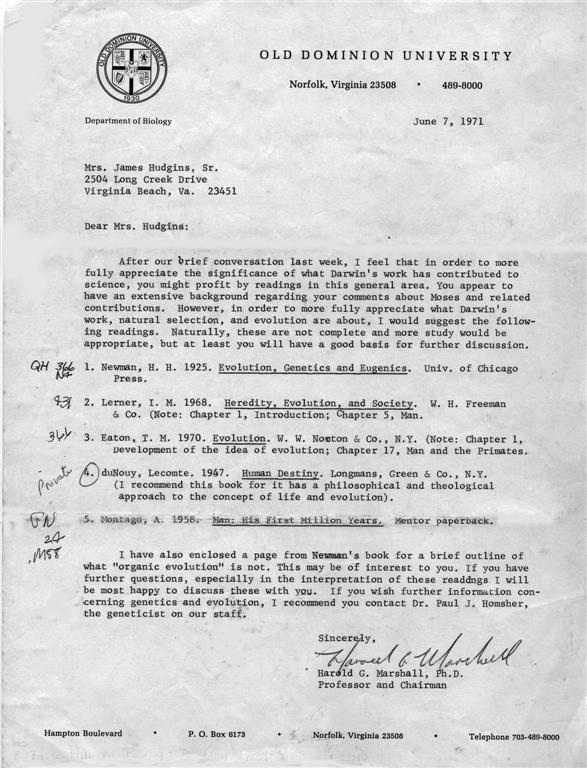
I.1.
Fig. 99.1. Plus Enclosure Included with Dr. Marshall’s Letter.

II.
Fig. 100. Scanned Copy of Dr. Clark’s Reply.
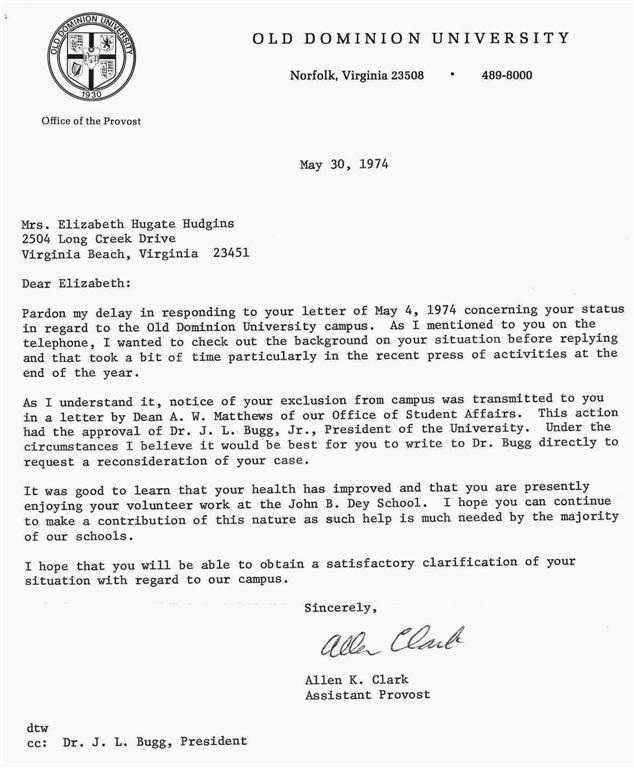
III.
Fig. 101. Scanned Copy of Dr. Bugg’s Acknowledgment to My Letter of May 19, 1975.
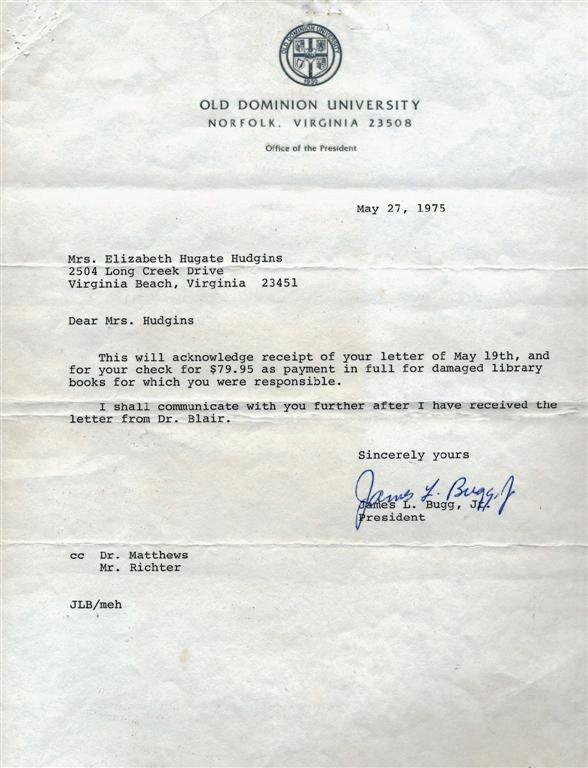 I V .
Fig. 102. An Optical Character Resolution Scanned Copy of Carbon of Letter Dr. Blair Sent to James Bugg, Jr.
I V .
Fig. 102. An Optical Character Resolution Scanned Copy of Carbon of Letter Dr. Blair Sent to James Bugg, Jr.
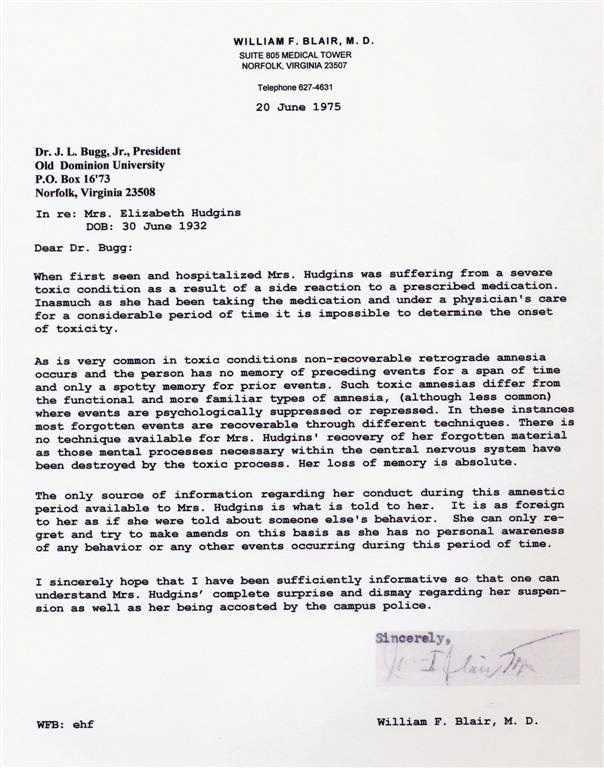
V.
Fig. 103. Copy of Reinstatement Letter Received from Dr. Bugg in June 1975.
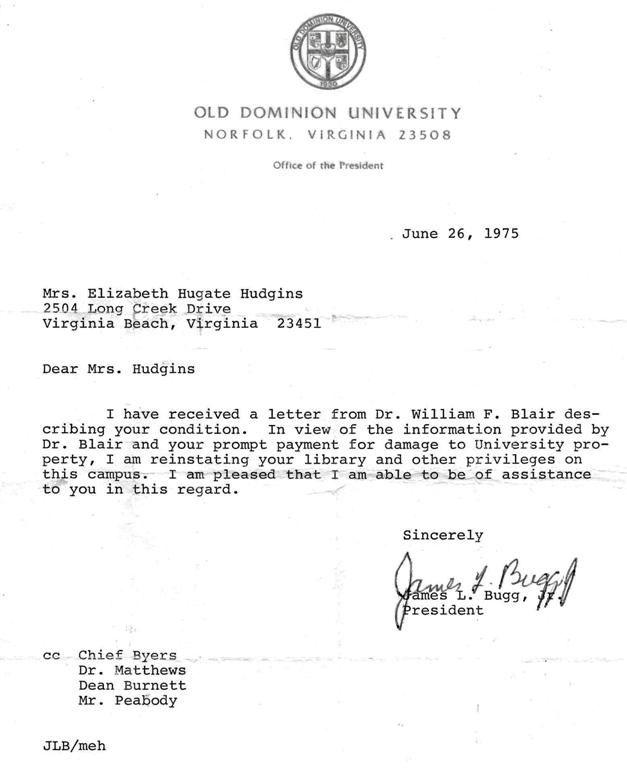
2 4
‘And Back, We Pray, . . .‘
_ _ _ _ _ _ _ _ _ _ _ _
Dates In Re: June 1975 - July 1991
Once the reinstatement was achieved, I more or less put the events from the 1968-1975 segment of my life behind me. Unsure of myself, and fearing to cause my family undue embarrassment, I did not talk with them about the transcendent experience I had undergone between January 14, 1969, and July 14, 1970. Neither were my four children told about what had transpired during my visit to














